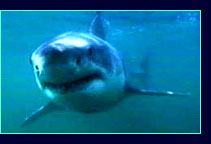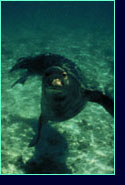 |

|

|
 To help the seal, you have to understand how scientists believe a
shark's senses might work together. All six senses are important, but a shark
relies on some more than others, depending on how far away the prey is.
To help the seal, you have to understand how scientists believe a
shark's senses might work together. All six senses are important, but a shark
relies on some more than others, depending on how far away the prey is.
- Hearing—The first signal a shark detects is often irregular, low-frequency
sounds made by an animal in distress. The shark turns and moves in the
direction of the sounds.
- Smell—As a shark swims, it senses the odor of prey and continues upstream,
crisscrossing the odor trail.
- Vision—When a shark is close enough to see the prey, it can better judge the
prey's location and whether it might be an acceptable meal.
- Feel—As a shark moves even closer, its lateral line sense helps it to
detect the prey's water movement. It might also feel the prey directly by
bumping it.
- Electroreception—At very close distances, a shark detects the location of
prey by sensing its electric field.
- Taste—At the final moment of attack, a shark often takes an initial bite, or
simply "mouths" the prey without biting, to decide if it is edible.
 OK, here's where the seal needs you. The shark has
heard and smelled the seal and is just starting to detect its movement in the
water. You're in a small motorboat next to the seal. What do you do? OK, here's where the seal needs you. The shark has
heard and smelled the seal and is just starting to detect its movement in the
water. You're in a small motorboat next to the seal. What do you do?
Cocos Island |
Sharkmasters |
World of Sharks |
Dispatches
E-mail |
Resources |
Site Map |
Sharks Home
Editor's Picks |
Previous Sites |
Join Us/E-mail |
TV/Web Schedule |
About NOVA
Watch NOVAs online |
Teachers |
Site Map |
Shop |
Search |
To Print
PBS Online |
NOVA Online |
WGBH
© | Updated June 2002
|
|
|



 To help the seal, you have to understand how scientists believe a
shark's senses might work together. All six senses are important, but a shark
relies on some more than others, depending on how far away the prey is.
To help the seal, you have to understand how scientists believe a
shark's senses might work together. All six senses are important, but a shark
relies on some more than others, depending on how far away the prey is. OK, here's where the seal needs you. The shark has
heard and smelled the seal and is just starting to detect its movement in the
water. You're in a small motorboat next to the seal. What do you do?
OK, here's where the seal needs you. The shark has
heard and smelled the seal and is just starting to detect its movement in the
water. You're in a small motorboat next to the seal. What do you do?